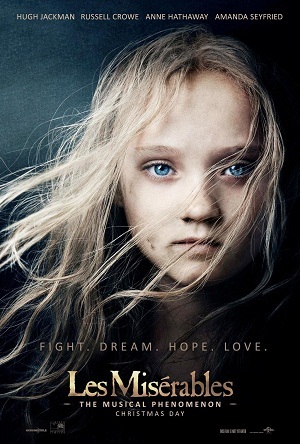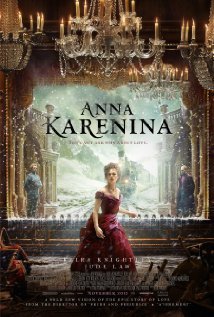This season offered moviegoers adaptations of two sprawling, classic novels, Les Misérables and Anna Karenina. They represent two rather different solutions to the inevitable problems of selection and compression when one is dealing with such huge stories. Both novels unfold over some time in their fictional worlds and, likewise, take the attentive reader days, months, or even years to absorb fully. But movies have only two or three hours to lay out the essentials and take the reader from emotional point A to point B, or to points X, Y, and Z.
In Les Misérables, the selection and compression of incident was given in advance by the adaptation for the stage, Boublil, Schönberg, and Kretzmer’s hugely successful musical. The undulating succession of emotional lows and peaks which Victor Hugo wrote are all here with a song to embody each. But is this a help to the film or too big a constraint on the pace of storytelling in a medium so different from the stage? The stage is a place where scenes can be rotated into view or merely suggested with a backdrop or a few props, where action is limited by space, and where audience and actors agree that a character may stop, lift us up (with the strength of a Jean Valjean!), and symbolically carry us through the emotional journey of a song. In a film, especially one that is avowedly “realistic” in its aim, the agreement is a bit different. The story is told scene by scene at more or less the pace of life; gaps in time–sometimes huge ones–serve the purpose of compression. The screenwriter’s and film director’s arts involve first selecting the scenes that will piece together the narrative and then setting them up (requiring again a whole universe of choices) for the camera to capture.
In Tom Hooper’s film of Les Misérables, the succession of songs seems to force a certain staccato pace on the events, as if they must be reeled out quickly before the song is over. Because this cuts against the grain of realism in what the eye sees, the film seems oddly rushed and busy, and star Hugh Jackman, as Jean Valjean, mirrors this pace in his valiant, breathy singing. Fantine’s fall from seamstress to prostitute, after selling her locket, hair, and teeth, apparently occurs all in the same day, in the space of a few desperate hours, while the song that brackets it takes mere minutes. The cuts and scene changes that permit the illusion of the passage of time, in a fine version such as the 1998 nonmusical film (starring Liam Neeson and Uma Thurman), are not available here.
Perhaps the frenetic pace of Fantine’s degradation conveys its tragedy, but as a viewer I was ironically grateful when the motion ceased while she sang “I dreamed a dream”–this song, both in the musical and in the film, bestowed the gift of time, room to contemplate all her character had undergone and would yet suffer.
Does this mean that a sung-through musical is not possible on film? Not at all. The Umbrellas of Cherbourg (1964), directed by Jacques Demy, is successful precisely because it never feels rushed or constrained by the songs; its dreamy quality matches song to action in a way that is awe-inspiring, justifying the admiration this film has received. For Les Mis, Hooper faced the doubly difficult task of adapting an adaptation, and he likely felt an obligation to include all the songs from the musical out of respect for its fans; but this ready-made “screenplay,” in song form, short-circuited the possibility of making a musical better adapted to screen storytelling.
In Joe Wright’s Anna Karenina, the artistic tables are turned. Other films to this point have used conventional realism and judicious scene selection to solve the problem of compressing Tolstoy’s massive masterpiece. Wright, however, used the freedoms and conventions of the stage to make a brilliantly unconventional adaptation.
Placing his actors on and off a theater stage allowed abrupt scene changes and mere suggestions of incidents that were not out of place but rather served the emotional impact of the story. When Vronsky’s horse suddenly and fatally tumbled off the stage, the viewer was jarred into real shock comparable to Anna’s, and “realism” of a very different sort was managed creatively (such a fall might indeed break a horse’s back or crush its rider). Yet it is not real–it’s a film, and we knew that “no animals were harmed in the making.” It’s an illusion achieved with cuts, special effects, and clever choices, part of the overarching illusion that the whole story can be recounted before the viewers’ eyes. Wright straddled film and theater, moving between them in a way that was surprising and constantly fresh, and a sophisticated commentary on both.
But Les Mis made a different set of choices: film realism and live singing. It has many strengths within those confines, not least of which is a complete realization of the stage musical. It fleshes out the action in epic proportions, to the point of floating a full-size galley (so it seems) for prisoner Jean Valjean to sweat and pull and sing into harbor. On this grand epic canvas, several other performances stood out and deserve mention. Anne Hathaway (Fantine) and Russell Crowe (Javert) found each of their character’s genuine center, and both sang very effectively. Anne will likely bring home many well-merited awards, probably an Oscar. Amanda Seyfried sang the aerial notes of Cosette with natural beauty and sincerity, and I would have wished more screen time for her. Eddie Redmayne (Marius), hitherto best known for playing Jack in The Pillars of the Earth, was a bracing surprise, for his screen charisma and excellent singing. But the biggest and most welcome surprise was the cameo of Colm Wilkinson as M. Myriel, the saintly bishop whose gifts of candlesticks and forgiveness purchased Jean Valjean’s soul for God, launching the miracle of his new life and pilgrimage of faith. Wilkinson reminds us of the possible heights an actor can reach in portraying the soul of a great man. Hugh Jackman embraces this challenge wholeheartedly and seems to understand the moral choices that beset Jean Valjean as well as the prayerfulness with which he approached those choices. As it did for Wilkinson in the stage musical, Jackman’s best moment arrived in the pivotal song, “Bring Him Home.” And so Jackman fulfilled the role, especially its greater physical demands in the film. Was he a “revelation” in the role? Perhaps not. But like Jean Valjean, he proved himself utterly faithful to it.
- Jean Valjean ranks 34th on The Fictional 100.
Related post:




















Recent Comments